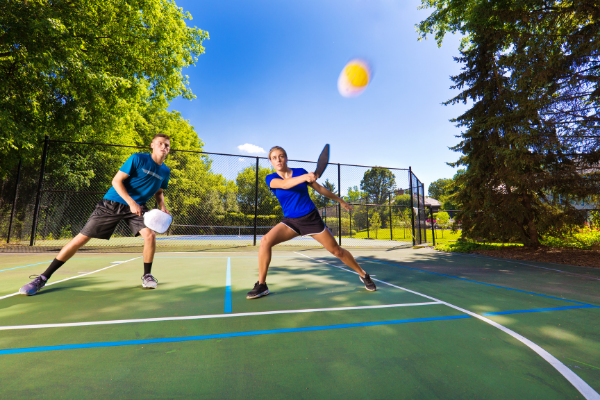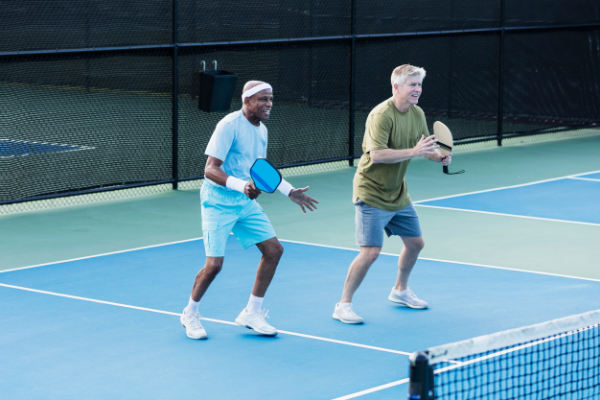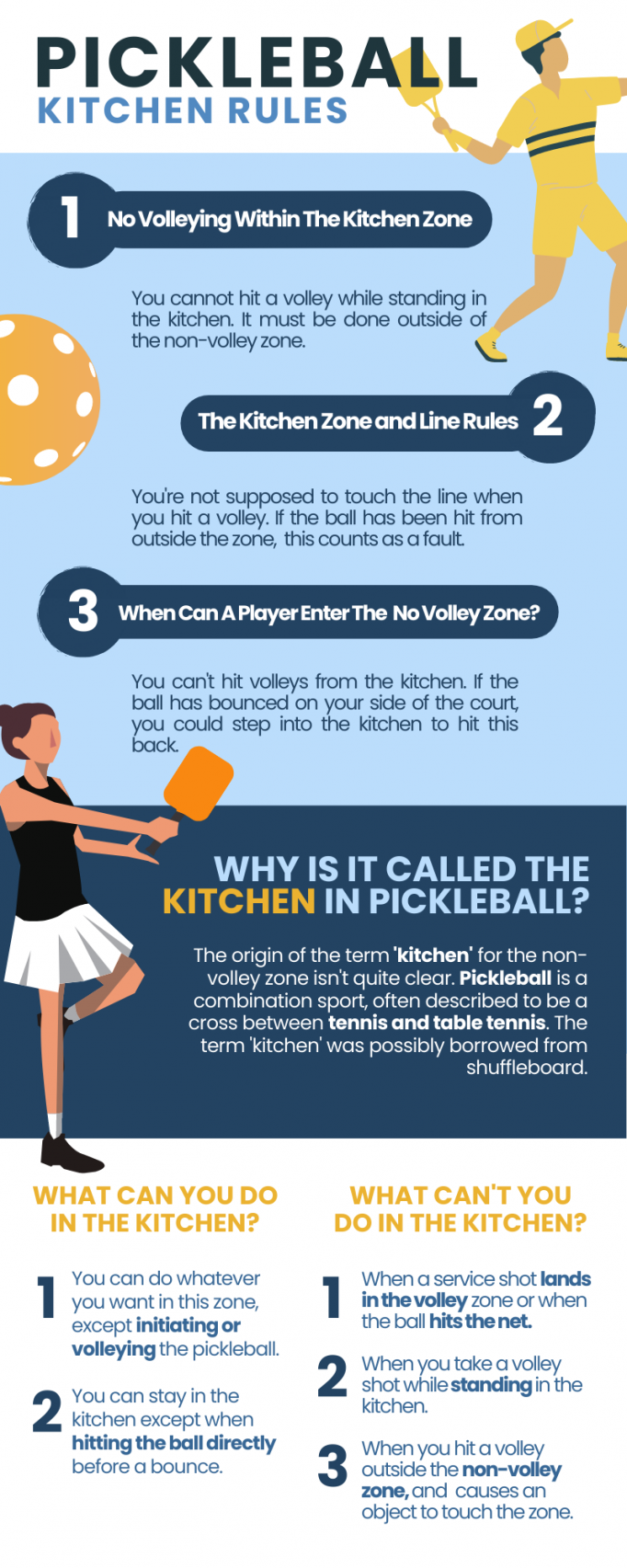There’s no denying that a game of pickleball is entertaining and amounts to a good workout. With the pickleball court divided into three parts, there are different rules for the different areas. You must particularly keep in mind the pickleball kitchen rules.
Although it takes time to get used to, breaking any of these rules results in a fault, and the score goes to the opponent team. Read on to know more about the kitchen rules.
What is The Kitchen in Pickleball?
Flickr by Michael & Sherry Martin
The non-volley or the kitchen zone is the seven feet of the ground area extending on both sides of the net and to each sideline.
If you’re a beginner, the non-volley zone rules or the kitchen rules are the easiest to break. Beginners, especially those who’ve played tennis, instinctively want to move closer to the net because that’s a tennis strategy. However, with the pickleball kitchen rules, players are prevented from smashing their hits downwards near the net.
The kitchen zone of the pickleball court is highlighted with different colors for demarcation of the boundary. The line marking the boundary of this zone is called the kitchen line or the non-volley line. These lines on both sides of the court are also considered part of the non-volley zone. Similar to all other lines on the pickleball court, the kitchen line also has a thickness of two inches.
What is A Volley in Pickleball?
An important term that defines the non-volley zone pickleball rules is ‘volley.’
A volley shot occurs when the ball is hit while it’s in the air before it bounces. When you hit a volley, the speed of the ball usually increases.
A groundstroke is the opposite of a volley and refers to the shot after the ball bounces. Such shots usually reach deep into the court and help keep up long rallies while getting the opponents running.
Pickleball Kitchen Rules
Certain pickleball kitchen rules make you aware of your actions while in the middle of a rally. These rules are unique to pickleball, setting it apart from other racket sports, and have been defined in the International Federation of Pickleball’s Official Tournament rulebook.
1. No Volleying Within The Kitchen Zone
The main pickleball kitchen rule is you cannot hit a volley while standing in the kitchen. If you want to volley, it must be done outside of the non-volley zone, between the non-volley line and the baseline of the court. To hit the ball before it bounces, you must stand outside the kitchen, and you mustn’t even touch the kitchen line.
For wheelchair-using players, it’s a legal shot if the front/smaller wheels touch the non-volley zone while attempting a volley.
The important part to remember about this rule is that it only applies if you touch the ground (so your feet), not the space above it. So you could still attempt to hit the ball in the air while you stand behind the kitchen line. However, there are other kitchen rules that you could risk faulting while trying this.
2. The Kitchen Zone and Line Rules
Since the kitchen line is also a part of the non-volley zone, even your foot isn’t supposed to touch the line when you hit a volley. Foot faults are more common with beginners and, occasionally, even with regular pickleball players. It’s a fault if anything the player is wearing or carrying touches or crosses this line.

Additionally, even if the ball has been hit from outside the zone, the volley’s forward momentum often carries you into the no volley zone; this counts as a fault. Despite a dead ball being declared on your opponents’ court, you must avoid the momentum of the volley from taking you within the zone. While you could try and prevent yourself from getting into the kitchen zone, you must be extra careful and avoid anything you’re wearing from crossing the line.
Technically, an act of volleying comprises the swinging motion, the follow-through, and the resulting momentum. Therefore, if your paddle touches or you drop it accidentally within the non-volley zone at any time during or after a volley shot, it’s considered a fault.
Also, you cannot try starting a volley shot in the no volley zone, looking to finish with a landing outside the kitchen line. If you’re about to hit a volley and move out of the kitchen zone, you must ensure both your feet are on the playing surface entirely out of the zone and the line before striking a volley.
The Serve
A good serve is when the serving team manages to get the ball in, meaning the ball hits either the baseline, centerline, or the sideline. The only pickleball kitchen rule that applies for a serve is that the ball must land beyond the kitchen line; if it as much as touches a part of the line, it’s considered an invalid serve. In this case, the rule states that the serve goes to the player’s partner for a doubles match or the opponent for a singles match.
It is a good strategy to aim your serve deep towards the baseline or at your opponents’ feet. However, if the serve happens to go out of the court’s bounds, it is considered an invalid serve. Unless you’re an expert at serving towards the baseline, the safer option would be to aim for the space between the kitchen line and baseline.
3. When Can A Player Enter The Pickleball No Volley Zone?
While you cannot hit volleys from the kitchen, you could attempt groundstrokes from the kitchen. If the ball has bounced on your side of the court, you could even step into the kitchen to hit this back to your opponents. Suppose you’ve hit after one ball bounce from the non-volley zone, then you needn’t exit the zone after you’ve hit the ball.
A commonly confused non-volley zone pickleball rule: it’s legal for you to hit a volley from outside the zone if you’re playing doubles pickleball and your partner is standing in the non-volley zone.
Related: Pickleball Rules Singles
Why is it Called The Kitchen in Pickleball?
The origin of the term ‘kitchen’ for the non-volley zone isn’t quite clear. However, it was most likely taken from another sport. Pickleball is a combination sport, often described to be a cross between tennis and table tennis. The term ‘kitchen’ was possibly borrowed from shuffleboard.
The 10-off area in shuffleboard is defined as the kitchen. The kitchen rule that applies to shuffleboard states that players landing in this space will result in a deduction of ten points. Similarly, you wouldn’t want to land within the kitchen line with pickleball. The interesting fact here is that although pickleball and tennis are similar, the use of the term ‘kitchen’ is the exact opposite. In tennis, the players specifically move closer to the net to volley.
What Can You Do in The Kitchen?
As much as the kitchen zone sounds dangerous, you can do whatever you want in this zone, except initiating or volleying the pickleball. You can stay in the kitchen any time of the game except when hitting the ball directly before a bounce.
Players commonly hop into the no-volley zone in pursuit of returning a short dink shot. This is a safe shot, as long as the ball bounces before you return it.
Double Bounce Rule

As per the rules of playing pickleball, after a serve, the opposing team has to let one ball bounce before they return it to the serving team, who must also let one ball bounce before the return. These mandatory two bounces are part of the double bounce rule. If this bounce occurs within the kitchen zone, you could hit the return while standing in the kitchen as well.
What Can’t You Do in The Kitchen?
Simply put, whatever is a fault or violation of any pickleball kitchen rules, is what you must avoid doing in the kitchen. Here’s what counts as faults in the kitchen zone:
- When a service shot lands in the volley zone or when the ball hits the net.
- When you take a volley shot while standing in the kitchen.
- When you hit a volley outside the non-volley zone, but the momentum of the shot carries you into the kitchen zone.
- When you hit a volley outside the non-volley zone, but the player’s momentum causes an object that was on the player to touch the zone. For instance, after a hard volley shot, your sunglasses or your hat may fall into the zone.
- When both you and your partner are standing in the non-volley zone, you can’t volley the ball.

Non-Volley Zone Pickleball FAQs
Here are a few other common questions people ask.
Q. If a high lob shot lands inside the kitchen and bounces up a good height, is it legal to return it with an overhand smash from within the kitchen?
A: Yes! With the ball bouncing once, it’s perfectly legal to return it from anywhere, including the kitchen.
Q. What is the purpose of the kitchen zone in a pickleball game?
A: Owing to the kitchen and its rules, the players are kept at a distance from the net and are prevented from smashing the ball. It extends rallies and negates the serve and volley advantage.
Q. What is ‘toeing the line’?
A: This pickleball phrase deals with foot placement while playing at the kitchen line. When you get quite close to this line with the toes portion of your court shoes, but not crossing the kitchen line is referred to as ‘toeing the line.’
Q. After hitting a groundstroke, is it a fault if your momentum takes you into the no volley zone?
A: As long as the ball has bounced once, regardless of where it bounced on the court, your momentum carrying you into the no volley zone after a groundstroke won’t result in a fault. Although, you must be careful not to hit a volley on the next shot from the kitchen.
Q. Who calls a kitchen violation in a game of pickleball?
A: If it’s a casual play for recreational purposes, any pickleball player in the game, either from your team or the opposite team, can call the violation of the non-volley zone pickleball rules. In case there’s a dispute, the priority to take a call is given to the player or the team that called the violation.
While playing in an official tournament, an official or a referee will be responsible for calling the violation.
Q. Is the non-volley line considered as in or out?
A: For a pickleball serve, it’s considered out if the ball lands within or on the kitchen line. For a serve to be valid, it must land beyond this line and can hit the centerline or sideline within the bounds of the court.
Following the execution of the serving shot, the ball landing on the kitchen line, even after the return of the serve shot, is legal, just like the other lines on the court.
Q. If I’ve hit a game-winning volley that isn’t returnable but carelessly stepped into the kitchen because of the forward momentum, does that winning point count?
A: When your momentum from the volley shot carries you into the kitchen, it’s always a fault; regardless of how long after the volley, you entered the zone. Despite having hit the game-winning volley, the point is invalid if you’ve stepped into the kitchen area.
To avoid such a situation, you could try and regain your balance or jump backward, negating the effect of the momentum, thus preventing a kitchen fault.
Q. Suppose a ball is obviously going to land in the kitchen, is it permitted to enter the kitchen zone before the ball hits the ground and hit it after it has landed in the kitchen?
A: You can enter the kitchen zone as long as you’re not volleying (hitting the ball before it bounces). It applies even when the ball hasn’t bounced on your side of the court yet. If you’re expecting the ball hit by the opponent team to bounce in the kitchen on your side of the court, you can enter the kitchen and return it. This doesn’t lead to a fault.
Q. Suppose you hit a volley shot and struggle to maintain your balance, trying to stay out of the kitchen. Is it a fault if the player’s momentum carries them into the kitchen after the opposite team has hit the ball back?
A: The player hitting the volley must refrain from even the momentum carrying them into the kitchen zone for the duration of that shot till it is returned. Entering the kitchen zone, whether willingly or caused by the volley’s momentum after the opponent team has hit the shot back, entering the kitchen zone definitely doesn’t count as a fault.
Q. Is it against the rules to stand in the kitchen when the opposite team is serving (to intimidate the server)?
A: It’s not against the rules. You can stand in the kitchen when the other team is serving. Although, a smart server will most probably hit the ball right at you, and if it hits you, the serving team gains a point.
Q. Once you’ve hit a volley shot, does it count as a fault if your partner holds you back to avoid your momentum from taking you into the kitchen?
A: Absolutely not! Your partner can hold you back to prevent you from moving into the non-volley zone because of the forward momentum from a volley shot. The only catch here is that neither must your partner be in the non-volley zone while holding you back.
Q. Is it a fault if you move into the kitchen from the momentum of the volley you just hit after the ball has bounced twice in your opponent team’s court?
A: Even if there is a dead ball (or the ball has bounced twice), you aren’t supposed to enter the no-volley zone, even with the momentum from the volley.
Q. If I’ve hit a high lob shot aimed at the opponent team’s kitchen zone, but they don’t hit it back, and the ball’s spin gets it bouncing back into my kitchen, is it a fault on the opponent’s side or does the rally continue?
A: Technically, the opponent team was supposed to strike the ball back to you. Since they didn’t hit the ball, it counts as a fault on them, making you win the rally.
Final Thoughts
With so many kitchen rules, it might seem complicated for beginners to play pickleball. While it might feel easier to stay out of the kitchen for most of the game, you might have to step into the kitchen zone based on how your opponent hits the ball. What you must try and avoid is volley motion that could easily cause anything from a foot fault to you or anything on you touching the non-volley zone.

